Advanced Biceps Workout
The advanced bicep routine shown within this article is designed more so for detail work of the arm, as opposed to size and strength, which were covered more within the beginner and intermediate workouts. Many of these exercises and training methods I had made use of during my competition prep, where I wanted to be able to show individual muscle heads, and clear separation between the major muscle groups.
This routine requires that you have a year or more of lifting experience, so as to have both the strength and know how to perform each movement effectively and efficiently. Much of these exercises are not your typical movements that you may be used to, and so if you’re still relatively new to weight training, I would recommend that you spend a solid 6-12 months familiarizing yourself with the beginner and intermediate routines, and building up your strength and use of various training methods before moving forwards with this particular routine.
Exercise 1: Incline Bench Curls
Target: 3 sets of 12-10 reps
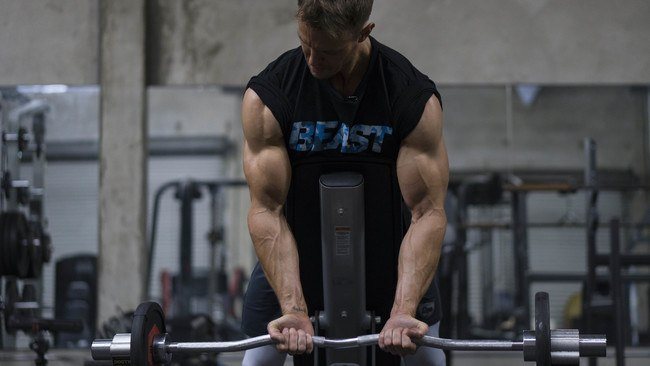
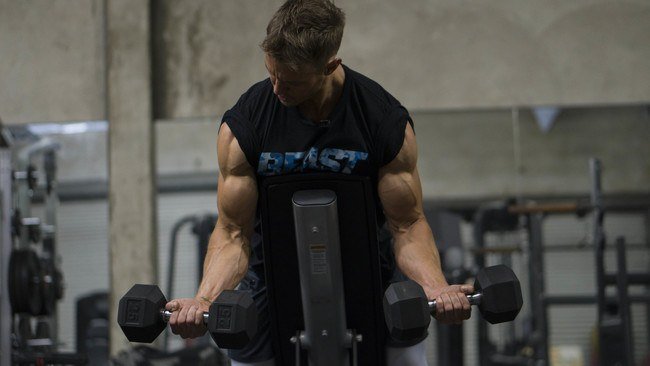
This particular set up, whereby your supporting your front body on an incline bench, with the arms hanging vertically down at the side of the bench, holding an EZ-Bar with a slight narrow grip, will intensely work the biceps and force them to do all the work with little to no assistance from other major muscle groups. Therefore, start with a lighter-than-usual weight and achieve your desired rep range before increasing the weights.
Once you’ve got the basic movement down, in which I’ll only raise the bar up to about until my forearms are parallel to the floor, otherwise my chest starts to get a pump (against the bench), and I feel my shoulders start to engage to help pull the weight up the rest of the way, you can make use of a number of different shocking principles. My favorites on here are to use rest-pauses and drop-sets. With both variables, try switching from a barbell to using dumbbells. You’ll soon find that you may need to lessen the weight, but it will also give you the freedom to change the angles of the arms as you lift. I’ve found that in working the muscles through a greater range of angles and using different variables in each working set, you’ll see greater conditioning and overall development, than if you were to simply stick with the same approach to each exercise, time after time.
Exercise 2: Concentration Curls
Target: 2-3 sets of 15-12 reps
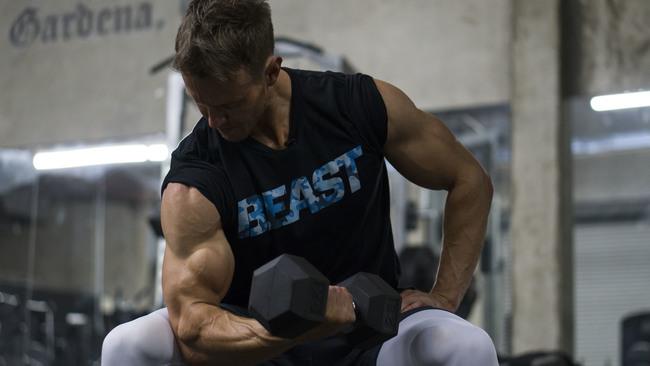
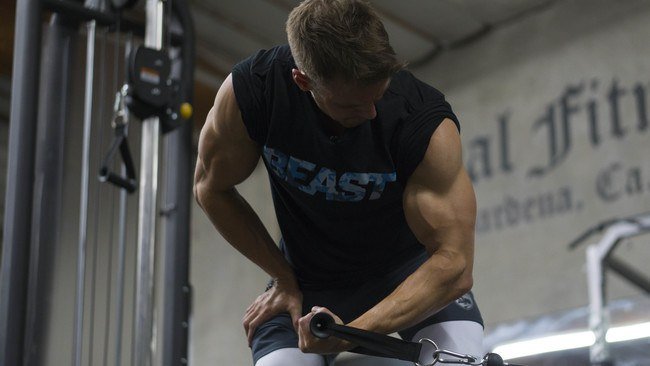
Concentration curls are another staple exercise for training the biceps, and often one that I don’t see too many people incorporating much into their routines. It’s a great movement that targets the inner bicep head, as well working the muscles in the forearm, and brachialis – the ‘third’ bicep muscle that sits deeper than the biceps brachii. It’s also great for unilateral work, as many bicep movements are typically performed with both arms at a time, but this one requires only one arm to be worked at a time.
It can be performed using a dumbbell or a cable. For the dumbbell version, you want the elbow to be positioned up against the inside of the knee, and angled slightly outwards so that as you curl up the dumbbell, it’s moving closer towards the opposite shoulder, which keeps the focus mainly on the inner, short head of the bicep. Allow for a full stretch in the bicep, opening up the bicep as much as possible. Try to keep the upper arm in a fixed position (the same vertical axis as your calf), so as to get full flexion at the elbow.
If performing with the cable, you stand in a similar ½ squat position as you would with a bent over barbell row, and place you resting arm on your upper thigh for stability. The arm that is lifting the weight is now no longer resting against the knee, but should still be kept as vertical and fixed as possible. Keep the elbow angled slightly outwards – facing the pulley, and curl the handle upwards as you concentrate on contracting the bicep.
I’ll perform one arm at a time, moving immediate from one set on one arm, into the next on the other arm, then allow no more than 60 seconds before starting the next set. Within my 3 working sets, I will typically perform 2 with the dumbbell, and finish the set using the cables.
Exercise 3: Cable Preacher Curls* & Seated Cable Curls
Target: 2-3 sets of 15-12 reps
*Each exercise is performed as a superset, one after the other with no rest.
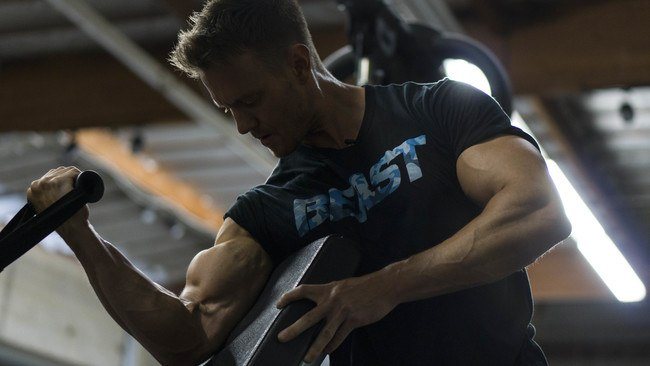
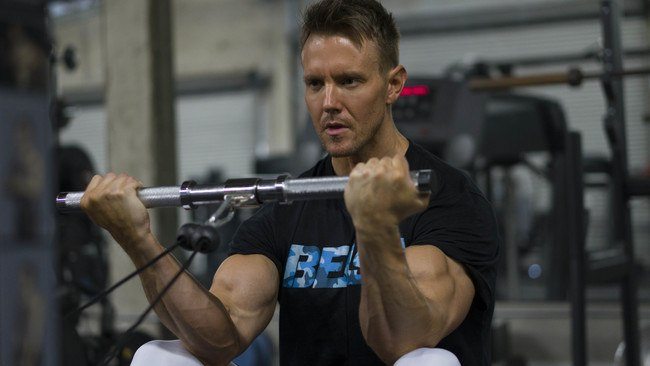
You’ll see me using the cables a lot within my workouts, especially for conditioning and full separation. This is because the weights are set on a vertical stack, and so any movement where the cable is being pulled; there will be a constant amount of resistance on the muscle throughout any point of the movement. Unlike when using free weights, or even some machines, you’ll find there to be certain sticking points and dead spots, which can affect how the muscles is being worked.
Starting with the cable preacher curls on a bench set to quite a steep incline, it’s practically the same set up as when using dumbbells, except as you curl the handle upwards, until the elbow just starts to lift away from the bench, you’ll feel the same amount of resistance throughout the entire range of motion. You may not be able to move as much weight with this set up, but you’ll be sure to feel an intense pump that will ensure the biceps, brachialis, and forearm muscles are being thoroughly worked.
Immediately following this, move on to the seated cable curls. This requires using a seated cable row, and supporting your elbows just on the inner regions of your knees, almost like a preacher bench. As you curl the short bar up towards your chest, you’ll feel your biceps (specifically the short head), get an intense pump, even without much weight. Hold this peaked position for a split second, before slowly resisting the weight back down until you have a full stretch in the biceps, (the weights should not be resting on the weight stack at this point, so tension is still kept within the muscles).
After finishing both superset movements, try holding an isometric hold for 10 seconds.
Advanced Bicep Summary
In summary, the advanced bicep routine should be used for when you’re focusing on maximum muscle definition, such as preparing the final few weeks before stepping on stage, or in the run up to a photo shoot, but it can also be put to use after spending 4-6 weeks on both the beginner and intermediate programs (just for 2-3 weeks at most), as a way to give the biceps a rest from the heavier free weights, and allow for greater conditioning of the muscles from a range of different angles.
Typically, I’d perform this type of workout once a week, focusing just on my biceps, although occasionally adding in a forearm circuit after completing all the bicep movements.